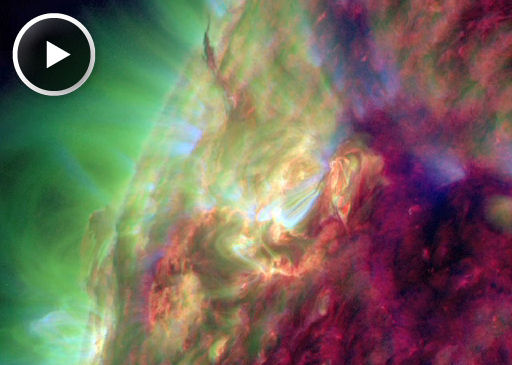THE DECAY OF PHOBOS-GRUNT: Russia's malfunctioning Mars probe, Phobos-Grunt, is sinking back into Earth's atmosphere. Taking into account the current space weather forecast and the area-to-mass ratio of the spacecraft, Ted Molczan estimates the time of re-entry: Jan 16 @ 07:00 UTC +/- 1.3 days. The window of uncertainty is still too large to pinpoint exactly where the fireball will occur. Check Spaceweather's Satellite Tracker for last-chance sighting opportunities.
WEEKEND SUNSPOT: Sunspots store energy in the high-tension twists and turns of their magnetic fields. During the late hours of Jan. 9th, the magnetic field of sunspot 1395 untwisted. The result was a C2.6-class solar flare and this movie from the Solar Dynamics Observatory:
The eruption did not produce a significant CME. Nor did the flash of UV radiation make big waves of ionization in Earth's atmosphere. It was not a geoeffective event.
Having untwisted, the magnetic field of AR1395 is now temporarily relaxed. Solar activity remains low and AR1395 is unlikely to break the quiet. Solar flare alerts:
![]()

![]()
Solar wind
speed: 447.1 km/sec
density: 3.5 protons/cm3
explanation | more data
Updated: Today at 1631 UT
![]()
X-ray Solar Flares
6-hr max: B7 1529 UT Jan10
24-hr: C1 0153 UT Jan10
explanation | more data
Updated: Today at: 1600 UT
![]()
![]()
![]()
Daily Sun: 10 Jan 12
![]()
![]()
Sunspots 1391 and 1393 have 'beta-gamma' magnetic fields that harbor energy for M-class solar flares. Credit: SDO/HMI
![]()
![]()
![]()
Sunspot number: 90
What is the sunspot number?
Updated 09 Jan 2012
Spotless Days
Current Stretch: 0 days
2012 total: 0 days (0%)
2011 total: 2 days (<1%)
2010 total: 51 days (14%)
2009 total: 260 days (71%)
Since 2004: 821 days
Typical Solar Min: 486 days
Updated 09 Jan 2012
The Radio Sun
10.7 cm flux: 142 sfu
explanation | more data
Updated 09 Jan 2012
![]()
![]()
![]()
Current Auroral Oval:
Switch to: Europe, USA, New Zealand, Antarctica
Credit: NOAA/POES
![]()
![]()
![]()
Planetary K-index
Now: Kp= 2 quiet
24-hr max: Kp= 2 quiet
explanation | more data
![]()
Interplanetary Mag. Field
Btotal: 5.9 nT
Bz: 2.8 nT north
explanation | more data
Updated: Today at 1637 UT
![]()
![]()
![]()
Coronal Holes: 10 Jan 12
![]()
![]()
A minor solar wind stream flowing from the indicated coronal hole should reach Earth on Jan. 13-14. Credit: SDO/AIA.





